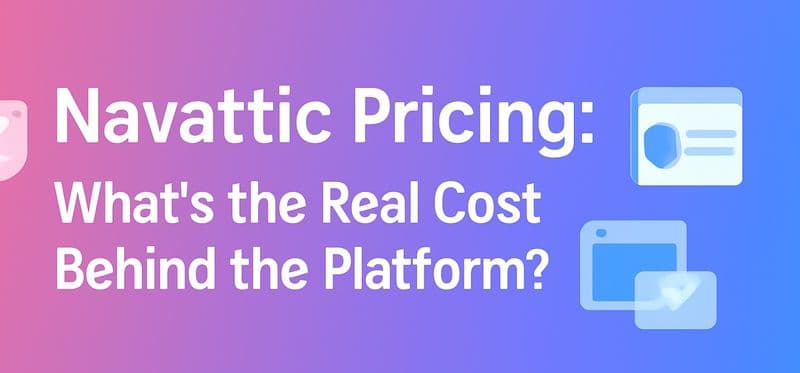
Key Highlights
Explore the top six TestBox alternatives for 2026, including SmartCue, Reprise, Walnut.io, Navattic, Demoboost, and Supademo.
Learn how each platform helps create interactive, hands-on demos that engage prospects effectively.
Understand key features to evaluate, such as customization, workflow personalization, analytics, and CRM/marketing integrations.
Compare pricing options, including free tiers, low-cost plans, and enterprise-level packages for different team sizes.
Discover use cases for proof-of-concept demos, pre-sales presentations, marketing campaigns, and onboarding.
See how the right demo platform can streamline workflows, shorten sales cycles, and improve overall buyer engagement.
Gain insights into ease of use and onboarding speed to get your team up and running quickly.
Creating product demos that truly connect with potential buyers is becoming increasingly difficult. Prospects now expect clarity, interactivity, and a real sense of your product’s actual capabilities, yet many teams are still stuck using rigid tours or static videos that don’t reflect real workflows. This gap between what buyers want and what teams deliver often leads to confusion, lower demo engagement, and delayed buying decisions.
For many SaaS companies, these frustrations become even more noticeable when using platforms like TestBox. While it offers value, TestBox can feel limited, expensive, or hard to scale, especially for teams that need flexible demo automation software, deeper customization options, or faster ways to let prospects explore the product.
This guide will help you cut through that noise. We’ll explore the top 6 TestBox alternatives for 2026, breaking down features, pricing, and how each platform supports stronger, more interactive product tours.
What is TestBox?
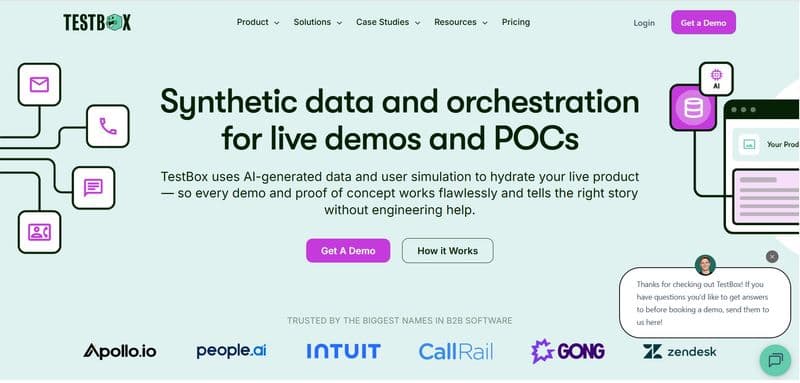
TestBox is an interactive demo platform designed to help SaaS companies showcase their products more effectively. It allows you to replicate your product in a controlled sandbox environment so that potential buyers can test the platform for themselves. Instead of a static presentation or a standard live demo, TestBox enables hands-on product demonstrations that let users explore product functionality at their own pace.
The platform uses AI to auto-populate these sandboxes with a viewer's own data, creating a highly personalized and relevant experience. This capability is valuable not only to sales teams but also to customer success teams, as it can be used for onboarding and training.
What Features Make TestBox So Popular?
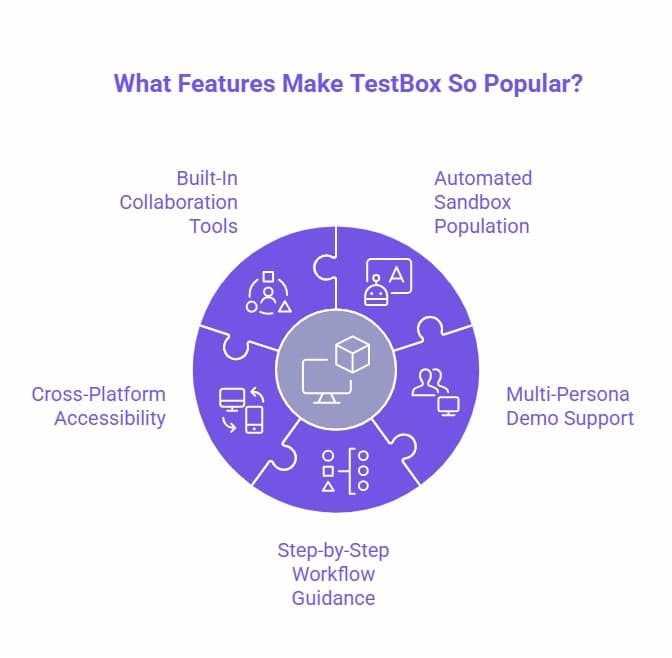
TestBox has earned its reputation for delivering high-impact, interactive product demos that effectively engage buyers. Its features go beyond basic demo creation, offering tools that help teams personalize, optimize, and scale their demo efforts efficiently. Here are the standout capabilities that set TestBox apart:
Automated Sandbox Population: The platform uses AI to automatically populate demo environments with realistic data, saving time and delivering tailored experiences for each prospect.
Multi-Persona Demo Support: TestBox allows creation of different demo versions for various buyer types or industries, helping teams present relevant workflows without rebuilding each time.
Step-by-Step Workflow Guidance: It structures complex product flows into digestible, easy-to-follow steps, helping prospects understand functionality without feeling overwhelmed.
Cross-Platform Accessibility: Demos can be delivered across web, desktop, and mobile, ensuring prospects have consistent, interactive access regardless of device.
Built-In Collaboration Tools: Teams can share, edit, and review demos internally, enabling sales, marketing, and product teams to maintain alignment and deliver consistent messaging.
How Do Different Businesses Use TestBox?
Different businesses use TestBox in their own way, depending on how complex their sales process is and how much time or budget they can invest in evaluations. Here’s how teams across various sizes typically use the platform:
Enterprise Teams Build Deep, Customizable Sandbox Environments: Large organizations rely on TestBox to create full product trials with realistic data and multi-step workflows, helping sales and presales teams deliver tailored evaluations without engineering support.
Mid-Market Teams Streamline Evaluations Across Multiple Products: These teams use TestBox to evaluate several SaaS products in one place, reducing back-and-forth and speeding up internal decision-making across departments.
Small Teams Create Limited Demos Due to Higher Pricing: Startups often build only a couple of focused demos, since TestBox’s cost makes large-scale demo libraries difficult, pushing them toward simpler, budget-friendly alternatives.
Customer Success Teams Use It for Onboarding and Training: CS teams leverage TestBox environments to guide new users through interactive workflows, improving activation and reducing support load.
Product Teams Test New Features With Realistic Data: TestBox’s sandbox-style setup helps product teams gather feedback on new updates, ensuring users experience changes inside a safe, controlled environment.
How Much Does TestBox Cost? A Breakdown of Its Pricing Plans
TestBox offers three structured pricing tiers designed around company size, product complexity, and data requirements. Here's a clear look at how each plan works:
Startup: Starting at $44,750/year for 15 users
Growth: Starting at $59,500/year for 15 users
Enterprise: Custom Pricing
Additional users cost $1,200 per user/year, and implementation fees vary by package.
Why Look for a TestBox Alternative in 2026?

Although TestBox is a robust tool, there are several reasons businesses explore the best TestBox alternatives for proof of concept demos for pre-sales demo automation, such as:
Cost: TestBox's pricing starts in the five-figure range for 15 users, making it difficult for smaller teams to justify. Many businesses switch to alternatives that offer flexible, lower-cost plans without sacrificing quality.
Feature Accessibility: Some essential features, like advanced workflows or deep integrations, are locked behind higher tiers. Teams that need these capabilities early often prefer tools that make core features accessible from the start.
Lead Capture & Analytics: While TestBox offers analytics, newer tools provide more streamlined dashboards and better behavior tracking. This helps sales teams quickly understand prospect intent and tailor follow-ups more effectively.
Ease of Use: As TestBox recreates full product environments, setup can feel heavy and technical. Alternatives with simpler, no-code capture make demo building faster and more accessible for GTM teams.
Faster Onboarding & Deployment: Some platforms let teams build polished demos within minutes using guided builders or Chrome extensions. This speed helps sales cycles move faster without long training or complex setup.
The good news is that there are several free and low-cost options available today that make interactive demos accessible for teams of all sizes.
Which 6 Reliable TestBox Alternatives Can Enhance Your Demo Automation Strategy?
Finding the right demo platform can transform how your team engages prospects. Here are six reliable TestBox alternatives to enhance your demo automation strategy:
1. SmartCue
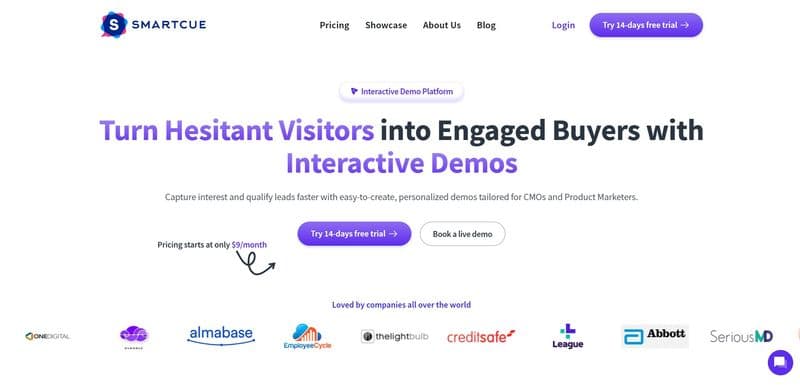
SmartCue is designed to help go-to-market teams present their product clearly without relying on engineering or complex setup. Rather than replicating the full product environment, SmartCue focuses on guided storytelling, capturing the exact path sales or marketing want buyers to experience. The platform is built to reduce friction in demo creation and speed up the delivery of polished, consistent product walkthroughs.
Key Features
Capture-Based Demo Assembly: SmartCue uses a capture-and-build approach that lets teams record product workflows and convert them into clean, interactive demos.
Structured Step-by-Step Narratives: Demos can be broken into digestible, guided steps that help prospects understand the product’s story in the proper sequence.
Multi-Channel Demo Distribution: SmartCue allows teams to share demos via links, embed them in webpages, or insert them into sales collateral.
Segmentation and Access Control: Teams can manage viewer access, assign persona-specific demo versions, and control how each demo is consumed.
Integrated Viewer Insights: Engagement reports highlight which steps prospects interacted with most, enabling teams to refine content for higher conversion rates.
Pros
Reduces Dependence on Technical Resources: Sales and marketing teams can build polished demos without waiting for engineering support.
Helps Standardize Product Messaging: Every rep delivers demos that follow the same narrative, reducing inconsistency across teams.
Shortens Demo Preparation Time: As demos can be reused, personalized, and shared quickly, reps spend less time preparing for calls.
Enhances Communication With Visual Clarity: By presenting only the curated workflow, product complexity is reduced, and value becomes easier to understand.
Supports Personalized Buyer Experiences at Scale: Teams can maintain multiple versions of a demo without rebuilding them from scratch.
Cons
Not Ideal for Complex, Multi-Step B2B Products: SmartCue works best for simple or mid-complexity product walkthroughs. Large SaaS platforms with multiple modules may find it restrictive.
Analytics Are More Basic Compared to Advanced Demo Tools: The platform does include engagement insights, but its analytics depth isn’t as robust as TestBox or other enterprise-focused demo automation tools.
Use Cases
Sales Demo Automation: SmartCue helps sales teams automate demo creation and deliver consistent walkthroughs across prospects.
Pre-Sales Enablement: Pre-sales teams use it to simplify complex workflows into clear, structured demo experiences.
Marketing Website Demos: Marketing teams embed demos on landing pages to increase engagement and conversion.
Product Onboarding: Product teams create interactive onboarding flows for new users.
Buyer Persona–Specific Tours: Companies use SmartCue to build demos tailored to multiple buyer profiles.
Pricing Tiers
SmartCue offers flexible plans to suit your team, such as:
14-day free trial
Essential Plan: $99 per user/year
Growth Plan: $300 per user/year
Enterprise Plan: Custom plan for larger teams with advanced integrations
User Response
"Super-useful for B2B SAAS Sales"
It's a simple, intuitive, and affordable product for sales teams of all sizes.
Ritu Soni S., Co-Founder, Small-Business
Experience how effortless demo automation can be with SmartCue. Start your 14-day free trial today and see the results for yourself.
2. Reprise
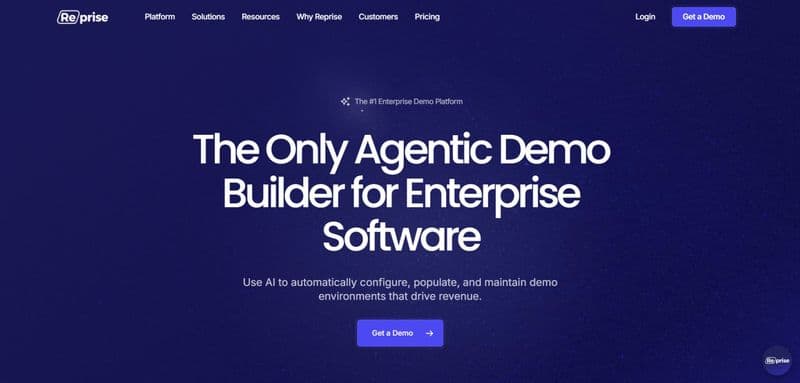
Reprise is built for companies that need demos to reflect the actual depth of their product, not a simplified or lightweight version. Unlike tools focused on guided tours, Reprise recreates full user experiences by replicating workflows, data states, and interface interactions. This makes it an ideal choice for organizations selling complex, multi-layered SaaS solutions that require technical accuracy during evaluations.
Key Features
Custom Environment Replication: Reprise enables teams to replicate product interfaces and flows without exposing sensitive backend systems.
Interactive Layer Editing: Users can edit text, visuals, and screens directly within demo environments to match prospect-specific scenarios.
Configurable Live Demo Modes: Sales engineers can switch between controlled and free-form demo modes during calls to adapt to buyer needs.
Scenario-Based Demo Paths: Teams can predefine multiple demo branches for different industries, roles, or technical skill levels.
Asset-Level Collaboration: Reprise includes team collaboration features that allow shared ownership of demo assets across product and SE teams.
Benefits
Ideal for Technical and Enterprise-Level Products: Reprise supports advanced workflows required for deeply technical or multi-module SaaS platforms.
Allows Complete Narrative Control: Teams control what buyers see, reducing demo risks caused by real-time product instability.
Enables Tailored Conversations During Live Calls: The platform's environment controls help SEs adapt demos based on real-time questions.
Helps Unify Enterprise Sales Teams: By managing multiple demo versions in one system, large organizations maintain alignment across regions and reps.
Reduces Pressure on Engineering Teams: Product and engineering teams no longer need to maintain separate demo environments.
Limitations
Longer Implementation Timeline: Reprise may require a lengthy onboarding and setup period, particularly for complex workflows.
Technical Involvement Required: Some configurations require assistance from engineering or technical teams.
Complexity of Demo Maintenance: Maintaining highly detailed or multi-module demos may require ongoing updates and internal coordination.
Higher Cost for Mid-Market Teams: The platform is priced for enterprise usage and may be expensive for smaller companies.
Feature Overload for Small Teams: Lightweight use cases may not require the depth Reprise offers.
Use Cases
Product-Led Sales Demos: Teams create clickable, interactive demos that showcase the product without needing a live environment or engineering help.
Customized Pre-Sales Experiences: Solutions engineers tailor demo versions for different industries, personas, and use cases so prospects always see what’s most relevant.
Marketing Website Tours: Marketing teams embed guided tours on landing pages to boost engagement and give visitors an instant, hands-on preview.
Onboarding and Training Flows: Customer success teams use Reprise to build walkthroughs that shorten the learning curve and speed up product adoption.
Feature Launch Education: Product teams create interactive flows for new feature releases, helping users understand updates without heavy documentation.
Pricing Structure
Reprise offers fully customized pricing built around your demo requirements. Instead of fixed tiers, the platform creates a personalized quote based on your team size, use cases, and demo complexity. Just share your requirements with their team to receive a tailored plan that ensures you only pay for the capabilities you actually need.
End-user Feedback
"Great software for reusable demos"
Its easy to use for both the demo builder and the end user.
Max S., Solution consultant, Enterprise
3. Walnut.io
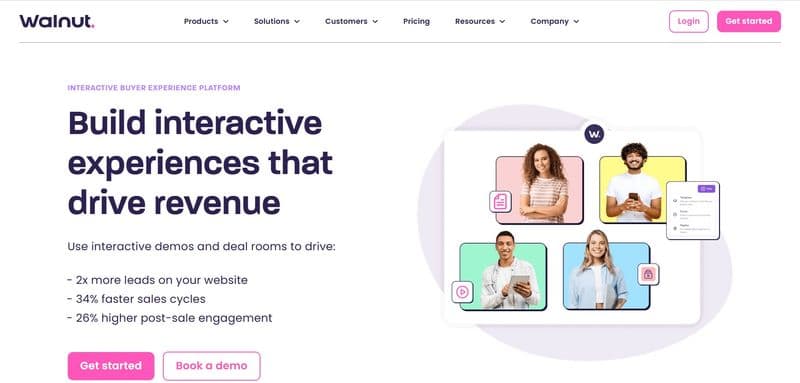
Walnut.io stands out as a leading platform for crafting interactive product demos that help businesses showcase their software without the risk of glitches or downtime.
Its browser extension makes it simple to capture your application's actual interface, after which you can use Walnut's intuitive no-code editor to modify and enhance each screen. This ensures your demos remain polished and professional, regardless of real-time product performance or backend changes.
Key Features
Data-Safe Demo Editing: Walnut removes sensitive or irrelevant data from demos to ensure privacy and compliance.
Dynamic Text and Image Personalization: Reps can personalize demo content, such as names, industries, or KPIs, in seconds.
Multi-Version Demo Libraries: Walnut helps companies maintain multiple demo libraries based on verticals, roles, or use cases.
Built-In Salesroom Experience: Demos can be packaged with notes, files, and next steps inside a dedicated buyer “salesroom.”
Version Control and Audit Trails: Teams can track revisions and maintain quality across multiple demo creators.
Strengths
Powers Buyer-Specific Storytelling: Walnut lets reps build demos that speak directly to each prospect's pain points.
Reduces Demo Errors and Risk: Since demos run independently of the live product, they avoid technical glitches.
Provides Scalability for Growing Sales Teams: Reps across different regions can access consistent demo assets.
Strengthens Competitive Positioning: Well-crafted demos help differentiate products in crowded markets.
Boosts Internal Efficiency: Teams reduce time spent preparing demos by reusing and customizing existing templates.
Limitations
Learning Curve: Walnut may require teams to spend time onboarding to adopt fully.
Potentially Complex Setup: Organizations with simpler demo needs may find Walnut more advanced than necessary.
Annual Billing: Walnut offers annual billing only, with no monthly option.
Higher Cost for Small Startups: Its pricing structure may not fit smaller teams or early-stage companies.
Less Suitable for Lightweight Demos: Walnut's capabilities are better suited to in-depth sales enablement than to top-of-funnel demos.
Use Cases
Personalized Sales Demos: Sales teams build tailored demos for each prospect, removing the risk of live demo glitches or shared environments breaking.
Pre-Sales Enablement: Solutions engineers create controlled demo flows that are easy to customize for industries, personas, and product lines.
Marketing Campaign Assets: Marketing teams embed frictionless demos in emails, landing pages, and ads to boost engagement and a qualified pipeline.
Customer Onboarding: CS teams use Walnut's guided flows to help new users learn core workflows, reducing the time needed for live onboarding.
Partner and Internal Training: Enablement teams build consistent demo versions for reps, resellers, and internal teams to stay aligned on product messaging.
Pricing Model
Walnut offers tiered plans designed for teams of all sizes, such as:
Ignite Plan: $750/month
Accelerate Plan: $1,550/month
Scale/Enterprise Plan: Custom pricing tailored for large teams with additional seats and enterprise capabilities.
User Perspective
"Standardized Demos and Top-Notch Content Control"
I appreciate Walnut's ability to standardize demonstrations throughout our organization, and its content control features are excellent, which is crucial for reducing operational and legal risks for our sales team. Additionally, I really liked the user interface and was able to develop a compliance-approved product script to help manage the narrative.
4. Navattic
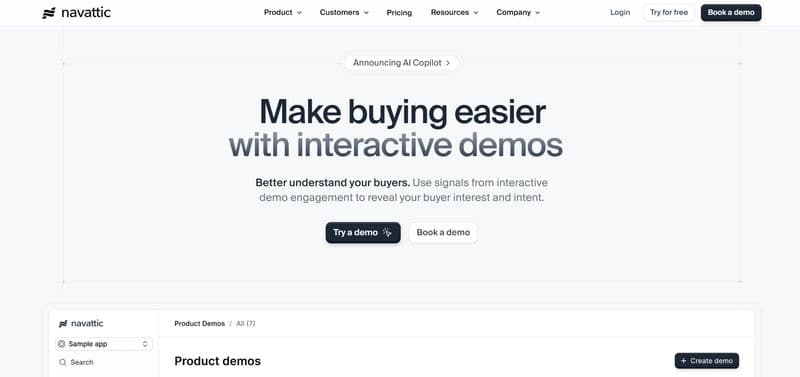
Navattic is an innovative interactive demo software designed to help businesses showcase their products in a highly engaging, user-driven format. By enabling you to create self-guided HTML demos that closely replicate the look and feel of your actual application, Navattic offers prospects a hands-on experience without the need for time-consuming sales calls or lengthy setup.
Key Features
Guided Snapshot Capture: Navattic captures static snapshots of product screens and transforms them into interactive experiences.
Embedded CTA Integration: Teams can embed call-to-action prompts within demos to encourage sign-ups, bookings, or downloads.
Lightweight Interaction Layers: Interactive overlays allow prospects to click, type, or navigate without heavy rendering or complex loading.
Demo Duplication Templates: Existing demos can be duplicated and modified for campaigns without having to rebuild from scratch.
Audience-Specific Entry Points: Navattic allows teams to create unique demo start points for different segments or marketing channels.
Pros
Highly Effective for Early-Stage Buyer Education: It helps prospects understand value before engaging with sales.
Enhances PLG Conversion Rates: Self-serve demos shorten the path from website visit to product interest.
Requires Minimal Technical Skill: Marketing and growth teams can build and launch demos without design or technical support.
Great for Campaign and Landing Page Testing: Demos can be A/B tested across different landing pages for optimization.
Works Well With Short Sales Cycles: Navattic is perfect for tools where users want fast information before signing up.
Cons
Limited Technical Simulation: Navattic is not designed to support deep, sandbox-style technical product simulations.
Not Suited for Enterprise SE Workflows: Technical sales teams may require more complexity than the platform offers.
Marketing-Centric Feature Set: Navattic's core strengths lie in top-of-funnel engagement rather than complete sales cycles.
Potentially Costly for Small Teams: Smaller organizations may find the pricing difficult to justify.
Additional Tools May Be Needed: Pre-sales, technical demos, or live demos may require separate platforms.
Use Cases
Top-of-Funnel Interactive Demos: Marketing teams embed HTML-based product replicas on landing pages to increase conversion and allow visitors to self-qualify.
Demo Centers for GTM Teams: Companies create full demo libraries tailored to different personas, industries, or use cases across GTM functions.
Sales Prospecting Experiences: Reps send personalized demo links that show value quickly, helping shorten early-stage sales cycles.
Product-Led Onboarding: Interactive walkthroughs guide new users through workflows without needing live training sessions.
Feature Rollout Education: Product teams highlight new features using controlled, interactive flows that help users understand changes immediately.
Pricing Tiers
Navattic's plans include options for beginners and growing teams, such as:
Starter Plan: Free
Starter Plus: $40/month
Base Plan: $500/month
Growth Plan: $1,000/month
Enterprise Plan: Custom pricing with advanced analytics and integrations
Client Feedback
"Great tool for a multitude of use cases and teams!"
Super easy to use and navigate. The platform is intuitive, and their knowledge center is vast for the things you are not able to easily figure out.
McKenzie J., Senior Director, Partnerships
5. Demoboost

Demoboost is a robust product demo software solution aimed at empowering revenue teams, including sales, marketing, and customer success, to deliver engaging, interactive, and highly personalized product tours. Its versatile screen capture functionality enables users to record both live product environments and staged demos, making it adaptable for a variety of products and industries.
Key Features
Click-Through Demo Builder: Demoboost enables teams to create demos by capturing screens and adding clickable interactions.
Session Playback Recording: Teams can record demo sessions and provide them to prospects for asynchronous review.
Engagement-Based Content Recommendations: The platform suggests improvements based on how prospects interact with existing demos.
GTM Workflow Integration: Demoboost fits neatly into marketing, sales, and customer success workflows.
Role-Based Demo Permissions: Admins can assign access controls based on team roles and demo categories.
Benefits
Short Learning Curve: Most teams can begin producing demos within the first day of adoption.
Ideal for Mid-Market SaaS Companies: It offers the right balance of features without enterprise complexity.
Enhances Prospect Follow-Up: Shared demos help reps follow up with context-rich, personalized messages.
Supports Multi-Team Collaboration: Marketing, sales, and CS teams can use the same demos for different purposes.
Improves Demo Reliability: Since demos are pre-built, they eliminate the risks associated with live-product instability.
Limitations
Fewer Integrations: Demoboost offers fewer native integrations compared to enterprise-focused platforms.
Limited Advanced Simulation: The platform is not designed for complex product simulations.
Requires Some Guided Setup: Certain workflows may require assisted onboarding for optimal use.
Not Suited for Technical Products: Deep technical demos may exceed Demoboost's capabilities.
Better for Mid-Market Than Enterprise: Large enterprises with complex needs may require more advanced tools.
Use Cases
Automated Pre-Sales Demos: SE teams produce tailored demo flows quickly, ensuring consistent performance without manual rebuilds.
Interactive Marketing Assets: Marketing can embed demos in campaigns to increase engagement and provide hands-on product understanding earlier.
Sales Follow-Ups: Reps send shareable demo links that prospects can revisit anytime, helping reinforce messaging after calls.
Onboarding and Tutorials: Customer success teams build step-by-step product experiences to reduce ramp time and support tickets.
Internal and Partner Training: Enablement teams maintain standardized demo versions for consistent product education across teams.
Pricing Structure
Demoboost provides fully customized plans tailored to your demo needs. Simply submit your team requirements online to receive a personalized quote that ensures you only pay for what adds value.
User Testimonial
"The Perfect Tool for a Solutions Engineer"
Really love the stability and ability to customize and build out workflows that can fit any scenario. Love that we can share workflows among our team and share with prospects!
James O., Solutions Engineer, Mid-Market
6. Supademo
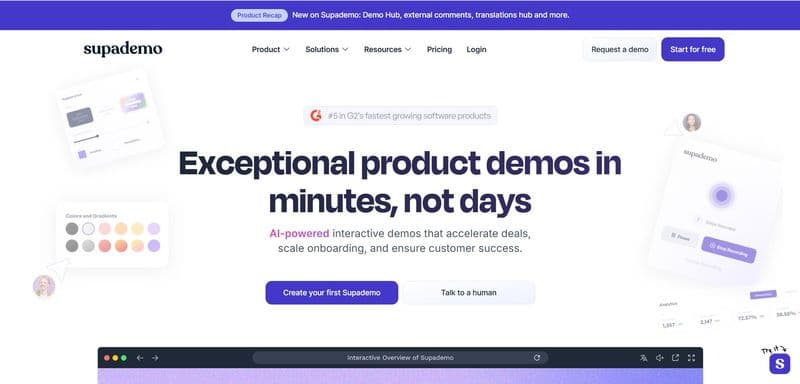
Supademo is engineered with efficiency and ease of use at its core, making it an ideal tool for teams that need to create interactive product demos quickly without sacrificing quality or clarity. Its intuitive interface lets users build step-by-step guides and walkthroughs in just a few minutes, eliminating the steep learning curve often associated with traditional demo-creation software.
Key Features
Instant Workflow Capture Engine: Supademo records user interactions and automatically organizes them into guided sequences.
Advanced Editing Timeline: Users can trim, reorder, or annotate demo steps through a visual timeline editor.
AI Voice Narration: The platform can generate natural-sounding voiceovers in multiple languages.
Scenario-Based Demo Routing: Supademo allows different branches based on user choices, questions, or preferences.
Flexible Export Options: Demos can be exported as videos, embeds, or interactive step flows depending on the use case.
Strengths
Great for Rapid Content Production: Teams can turn raw workflows into finished demos within minutes.
Perfect for Multilingual Needs: Supademo's AI-powered translation is a strong advantage for global teams.
Useful Across Multiple Teams: Marketing, product, support, and sales can use the same demo assets for different goals.
Low Cost of Adoption: Supademo provides premium-level features at an accessible price point.
Easy to Share Across Channels: Demos can be shared across email, social, websites, onboarding, and help centers.
Limitations
Free Plan Restrictions: The free plan limits users to five demos.
Advanced Features Require Higher Plans: Sandbox and advanced personalization are available only on premium plans.
Limited Integrations: The platform offers fewer integrations than enterprise competitors.
Not Ideal for Deep Technical Demos: Highly complex enterprise simulations may exceed its capabilities.
Scaling Costs for Larger Teams: Per-creator pricing can increase total cost for bigger organizations.
Use Cases
Quick Guided Product Tours: Teams create simple capture-based demos in minutes, perfect for onboarding or showcasing workflows.
Marketing and Website Embeds: Marketers embed clean, autoplay demos on landing pages, blogs, and help centers to boost clarity and conversions.
Sales Prospecting Links: Reps share short demos through email or chat to give prospects a quick, self-guided preview before a live call.
Support and How-To Tutorials: Support teams use Supademo to create fast visual explanations for FAQs, reducing back-and-forth and ticket load.
Product Updates and Release Notes: Product teams include short walkthroughs in release communications to show updates clearly and reduce confusion.
Pricing Model
Supademo's pricing is flexible and creator-based. Let's have a look at its plans:
Starter Plan: Free for one creator
Scale Plan: $38 per creator/month
Growth Plan: $350/month for five creators
Enterprise Plan: Custom plan for larger teams
User Feedback
"Really easy to create engaging demos."
Really easy to create engaging demos, so potential customers can see what the product will look like before requesting a trial. Also very affordable, too, and easy to integrate within our website.
Lee R., Digital Marketing & Ecommerce Executive, Small-Business
Which TestBox Alternative Fits Your Team's Workflow Perfectly?
Choosing the right demo automation platform can feel overwhelming, given the many strong TestBox alternatives available. Each tool offers unique benefits, from ease of use and advanced customization to pricing flexibility and integration capabilities.
To simplify your decision, let's compare the top competitors head-to-head. This comparison highlights key features, user experience, pricing, and support, giving you a clear view of which platform best fits your pre-sales, proof-of-concept, and interactive demo needs.
Feature | SmartCue | Reprise | Walnut.io | Navattic | Demoboost | Supademo |
|---|---|---|---|---|---|---|
Demo Creation | Chrome Extension / Guided Demos | App & Screen Capture | Screen Capture | HTML Cloning | Screen Capture | Step-by-Step Guides |
Customization | High | High | High | Moderate | Moderate | Moderate |
Pricing Plans |
| Custom Enterprise Quote |
|
| Custom Quote |
|
Key Focus | Ease of Use | Flexibility | Sales Enablement | Website Demos | Demo Library | Speed & Simplicity |
Integrations | HubSpot, Salesforce, Marketo | Salesforce, HubSpot, CRMs | Salesforce, HubSpot, Marketo | HubSpot, Salesforce, Marketo | Limited Integrations | Limited Integrations |
Analytics & Reporting | Viewer Insights | Performance Metrics | Multi-Version Analytics | Campaign Insights | Engagement Tracking | Lead Behavior Tracking |
Ease of Use / Onboarding | Quick, no-code editor | Moderate, technical setup required | Fast, intuitive no-code editor | Easy to set up, HTML-based | Moderate, some guided onboarding | Easy, step-by-step editor |
Security & Compliance | Sandboxed demos | Secure sandboxed environments | Data-safe demo editing | Secure HTML clones | Sandboxed, role-based access | Secure interactive demos |
Conclusion
Choosing the right TestBox alternative can genuinely transform the way your team creates and delivers product demos. The strongest platforms don't just replicate your product; they help you craft interactive, high-impact experiences through customization, integrations, and meaningful analytics.
When you pick a tool that balances simplicity, flexibility, and cost, your demos become more relevant, more consistent, and far easier to plug into your sales and marketing workflows. That alignment helps your team communicate value faster and more clearly.
By taking the time to compare your options, you set your business up for shorter pre-sales cycles, better qualified leads, and product experiences that stand out long after prospects close the tab.
Frequently Asked Questions
What are the most affordable TestBox alternatives for startups?
Startups can explore TestBox alternatives like SmartCue, Navattic, or Supademo, which offer free or low-cost plans. These platforms allow small teams to create interactive demos, capture leads, and showcase proof-of-concept workflows without significant upfront investments.
Which demo automation platform offers the fastest onboarding process?
Platforms like SmartCue and Walnut.io provide intuitive, no-code editors and Chrome extension-based capture, enabling teams to create interactive demos in minutes. Quick setup helps sales and marketing teams deliver personalized experiences immediately.
Which TestBox alternatives integrate well with sales and marketing tools?
Platforms such as SmartCue, Reprise, Walnut.io, and Demoboost connect easily with CRM and marketing automation systems. These integrations allow teams to capture engagement insights, sync lead data, and optimize demo-driven sales workflows efficiently.
What are the main differences between TestBox and Demostack for demo automation?
TestBox focuses on full trial environments that let prospects test real product workflows, while Demostack centers on controlled, editable demo replicas. TestBox feels more hands-on; Demostack offers tighter customization, faster setup, and safer, error-free demo experiences for GTM teams.
What are the best alternatives to TestBox for demo automation in 2026?
Top TestBox alternatives in 2026 include SmartCue Navattic, Walnut, Reprise, Demoboost, and Supademo. These platforms offer faster setup, easier editing, stronger customization, and more flexible pricing, making them popular choices for GTM teams needing scalable demo automation.
What do users say are the pros and cons of switching from TestBox to a competitor?
Users appreciate lower pricing, easier setup, and faster demo creation when moving to alternatives. However, they often miss TestBox's fully sandboxed product trials. Competitors offer speed and flexibility, but may lack the depth of TestBox's real-environment experience.
What should I consider when choosing between TestBox and Walnut for product demos?
TestBox offers real product trial environments, while Walnut provides controlled, customizable demo flows. Choose TestBox if you want hands-on product testing, and Walnut if you need polished, predictable demos that work consistently across sales and marketing teams.
Which platforms are best for small teams or startups?
Navattic, Supademo, and SmartCue are ideal for startups and small GTM teams. They provide simple, intuitive interfaces and low-cost or free plans, enabling teams to create interactive demos and proof-of-concept workflows without large upfront investments.
Which alternatives offer multi-channel demo delivery?
SmartCue and Supademo support multi-channel demo sharing. Teams can distribute demos via direct links, embed them on landing pages, or integrate them into sales collateral, giving marketing and sales teams flexible ways to engage prospects across different touchpoints.
